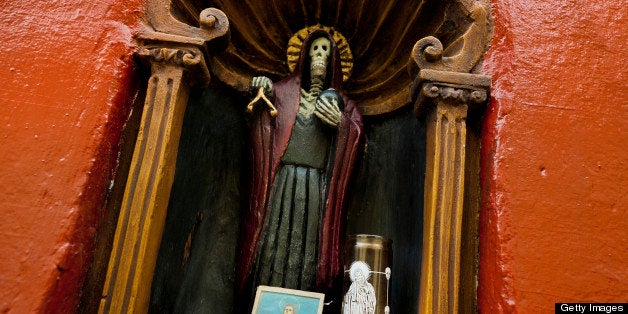
It was the declaration of Santa Muerte as an enemy of the Mexican state by former president Felipe Calderon that first sparked my interest in the skeletal folk saint. Identifying Santa Muerte as a "narco-saint" responsible for protecting certain drug cartels, the Calderon administration ordered the army to bulldoze some 40 shrines along the U.S.-Mexican border in March 2009. Now, four years later, the Vatican has followed suit and condemned Saint Death as an "infernal" and "blasphemous" figure worshiped by Mexican narcos. Over the past month, the President of the Pontifical Council for Culture, Cardinal Gianfranco Ravasi, has denounced the mushrooming cult of the skeleton saint on four separate occasions. The Italian prelate, whom veteran Vatican watcher John Allen recently called "the most interesting man in the Church" and even profiled as papible, first inveighed against the "Bony Lady" (one of Saint Death's most common monikers) during an interview in mid-April with a Peruvian Catholic news site (Aciprensa). Rejecting her (she's a female figure) as "sinister and infernal," one of the Vatican's most powerful men called for both Church and society to mobilize against devotion to Saint Death. "Everyone is needed to put the brakes on this phenomenon, including families, churches and society in its totality." The cardinal posited that devotion to Santa Muerte "is the celebration of devastation and of hell."
Ravasi, an influential member of the Curia, then took his message directly to Mexicans during his four-day visit there last week to lead his pet project, the "Courtyard of the Gentiles," a Vatican program designed to engage with and evangelize non-believers. Mexico became the first non-European country to host a Courtyard program. With three further condemnations of the saint of death on her home turf, the Courtyard of the Gentiles quickly morphed into the Court of Heresy in which Santa Muerte was pronounced guilty of blasphemy against religion (read Catholicism) and given the death penalty. Cardinal Ravasi depicted devotion to the skeleton saint as an idolatrous narco-cult masquerading as religion. Unfortunately, journalists covering the Cardinal's anti-Santa Muerte tour did not include interviews with devotees in their stories, but I know from my own extensive research that many disregard ecclesiastical denunciations even though they consider themselves Catholic.
Having closely monitored the development of Saint Death's burgeoning cult on both sides of the U.S.-Mexico border, I had expected a condemnation by the Vatican, although I am somewhat surprised that it came before any such statement made by U.S. bishops. So, why has the Vatican chosen this particular historical moment to declare its condemnation of Santa Muerte? In line with previous condemnations of the cult of the skeleton saint made by Mexican bishops, the President of the Pontifical Council for Culture rejects veneration of the Mexican folk saint on theological grounds. From the Christian perspective, Christ defeated His last enemy -- death -- through His resurrection. Thus, the veneration or worship of a figure of death is tantamount to honoring the enemy of Christ, or Satan. Most of the statements made by the Mexican Church hierarchy imply that devotees of Santa Muerte engage in Satanism unwittingly. Church officials are well aware of high profile criminal cases in which devotees of the skeleton saint have committed abominable crimes in the name of Saint Death. Narco-hits, human sacrifice and other lurid crimes have been committed in Mexico, and to a lesser extent in the U.S., by a small minority of Santa Muertistas who believe that she sanctions if not blesses such despicable deeds.
In addition to theological objections, the current religious economy of Mexico and Latin America provides a compelling explanation not only for the condemnation of narco-saints but also for other dynamic religious competitors. For the past three decades both national bishops' conferences and the Vatican have inveighed against the "invasion of the sects" in Latin America. Of course, Pentecostals, the most vibrant of the Church's competitors, have been the primary object of condemnation, but Mormons, Jehovah's Witnesses, New Age groups and Spiritists have also been singled out. Pope John Paul II even shone a global spotlight on the situation during his trip to the Dominican Republic in 1992 when he accused Pentecostal evangelists of being "rapacious wolves" raiding the Catholic flock. Thus, in the context of Catholic decline in Latin America over the past half-century, in which Brazil, home to the largest Catholic population on earth, might not even be a Catholic-majority country within 15 years or so, the Church, particularly in Latin America, is in a state of panic over its losses. Even more disconcerting for the hierarchy is the fact that Latin America was 99 percent Catholic as late as the 1940s, but has plummeted since to the current figure of 70 percent. These trends, more than any other reason, reveal why a cardinal from Latin America was chosen as the new pope.
Concern with Santa Muerte's cult at the Vatican has undoubtedly been fast-tracked by the election of the first Latin American pontiff, Pope Francis, and by his appointment of Honduran Cardinal Oscar Rodriguez Maradiaga to head the recently formed papal advisory council of eight cardinals. Furthermore, Pope Francis is probably familiar with Santa Muerte's Argentine cousin, San La Muerte, who is the second of three skeletal folk saints who are the objects of widespread devotion in the Americas. San La Muerte, like his Mexican counterpart, appears regularly in Argentine crime tabloids and has also been rejected as a heretical cult by the Church there. It's also likely that Cardinal Maradiaga had been aware of Santa Muerte prior to Cardinal Ravasi's denunciations as recent press reports in Honduras have focused on devotion to her there with one even reporting the torching of her effigy in a bonfire set by local police. In addition to the top two prelates at the Vatican being Latin American, Saint Death has been a regular in the global press since my book, "Devoted to Death: Santa Muerte, the Skeleton Saint," came out last year. As the first English language academic book on the subject, it has been the basis for many high-profile news stories on the skeleton saint. In brief, theological concerns, religious competition, unprecedented Latin American influence at the Vatican, and media coverage have converged and laid the foundation for the Vatican's condemnation of the cult of Santa Muerte as the poster child of Latin America's "culture of death."

